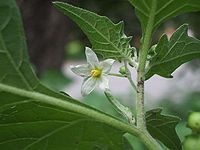
Photo from wikipedia
ETHNOPHARMACOLOGICAL RELEVANCE Solanum lycocarpum St. Hill. (Solanaceae) is widely distributed in the Brazilian cerrado and is used in folk medicine for treatment of inflammatory disorders, such as asthma and hepatitis,… Click to show full abstract
ETHNOPHARMACOLOGICAL RELEVANCE Solanum lycocarpum St. Hill. (Solanaceae) is widely distributed in the Brazilian cerrado and is used in folk medicine for treatment of inflammatory disorders, such as asthma and hepatitis, as weel as antirheumatic. AIM OF THE STUDY The aims of this study were to evaluate the antioxidant, anti-inflammatory and antinociceptive activities of the ethanol extract (EE) obtained from the ripe fruits of S. lycocarpum and to identify its chemical constituents. MATERIALS AND METHODS The extract was obtained by percolation with ethanol. This extract was analyzed by liquid chromatography coupled to a diode array detector and mass spectrometer (LC-DAD-MS) for identify its chemical constituents. The antioxidant activity was determined by the reaction with 1,1-diphenyl-2-picrylhydrazyl radical (DPPH). In vivo anti-inflammatory potential was assessed using carrageenan-induced paw edema model, while qualitative and quantitative histological analyses evaluated of the inflammatory infiltrate at different times and treatments. The antinociceptive effect of the EE was evaluated by acetic acid-induced abdominal writhing test, formalin-induced nociception and hot-plate test. RESULTS The main compounds identified in EE were steroidal glycoalkaloids (such as robeneoside B or hydroxysolasonine isomers and solanandaine isomers), the aglycone alkaloids peiminine and solasodine, di- and tri-O-caffeoylquinic acid derivatives, O-coumaroyl caffeoylquinic acid derivatives, N1,N10-bis-(dihydrocaffeoyl)spermidine, di-O-hexoside, and hexonic acid. In addition, the EE showed significant antioxidant activity. Intraperitoneal (i.p.) treatment with EE (300 mg/kg) exhibited anti-inflammatory activity. Qualitative and quantitative histological analyses showed that EE significantly reduced the cell infiltrate in acute inflammation. The EE, in all doses evaluated, significantly reduced the abdominal contortions in mice. Besides, reduced licking time was found in both phases in the formalin test after treatment with EE (100 and 300 mg/kg). In addition, the opioid receptor antagonist naloxone reversed the antinociceptive activity of morphine in the both phases the test, but it did not reverse the antinociceptive activity of the EE. The EE (300 mg/kg) also caused an increase in the latency to response in the hot-plate test. CONCLUSION The ripe fruits of S. lycocarpum exhibit antioxidant, anti-inflammatory, and antinociceptive activities, attributed mainly to the presence of alkaloids, such as solasodine and peiminine, as well as caffeoylquinic acids in their chemical composition. These results contribute to use of S. lycocarpum ripe fruits for the treatment of inflammatory and painful process.
Journal Title: Journal of ethnopharmacology
Year Published: 2020
Link to full text (if available)
Share on Social Media: Sign Up to like & get
recommendations!